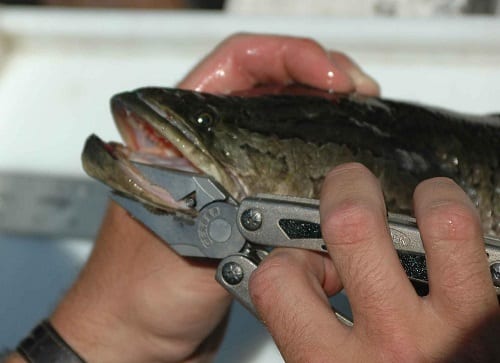BALTIMORE, MD – A partnership overseeing fish passage at the Conowingo Dam reports that 81 northern snakeheads were caught in the dam’s fish lift this spring, a dramatic increase after only one snakehead was found there the past two years.
While all known snakeheads were stopped and dispatched before reaching the dam’s reservoir, the Maryland Department of Natural Resources and its partners warn of a possible northern expansion by the aggressively invasive species into the Susquehanna River.
Two fish lifts were installed on the east and west sides of the Conowingo Dam decades ago to allow passage of migratory fish such as American shad and river herring. The fish lifts are critical for migratory species restoration and a requirement by the Federal Energy Regulatory Commission.
These fish lifts operate during the spring migration, which is also when snakeheads are known to travel longer distances in the watershed. All snakeheads captured this year were in the western side of the dam.
In 2017, one snakehead was observed passing from the lower Susquehanna River and upstream to Conowingo Pond through the east fish lift. An agreement was established in 2018 between the Conowingo Dam’s owner, Exelon, and the Susquehanna River Anadromous Fish Restoration Cooperative (SRAFRC) to implement voluntary, adaptive best management practices that reduce the spread of northern snakeheads while still allowing migratory fish passage.
Smaller dams upstream of Conowingo Pond, which include Holtwood, Safe Harbor, and York Haven, may also slow the spread of snakeheads in Susquehanna River to Pennsylvania and New York.
SRAFRC is an interagency cooperative organization comprised of the fishery agencies from New York, Pennsylvania, Maryland, the National Marine Fisheries Service (NOAA Fisheries), the Susquehanna River Basin Commission, and the U.S. Fish and Wildlife Service.
The Maryland Department of Natural Resources is increasing its efforts to educate the public about the northern snakehead, having introduced several informational videos, supplemental fact sheets and an updated webpage.
Northern snakeheads were first observed in Maryland waters in 2002, and shortly after its discovery in Potomac River in 2004, the species gained a foothold in tidal waters. Since then it has spread to every major tributary of the Chesapeake Bay.
The northern snakehead is a species of snakehead fish native to China, Russia, North Korea, and South Korea, ranging from the Amur River to Hainan. It has been introduced to other regions, where it is considered invasive. In Europe, the first report of the species was from Czechoslovakia in 1956. In the U.S., the “frankenfish” is considered to be a highly invasive species. In a well-known incident, several were found in a pond in Crofton, Maryland, in June 2002, which led to major media coverage and two movies.
On the night of May 24, 2018, Andrew “Andy” Fox of Mechanicsville, Maryland shot a northern snakehead with a bow and arrow, which was officially listed as the biggest ever shot according to the Maryland Department of Natural Resources. The record-breaking northern snakehead weighed 19.9 lb, with a length of 35.157 inches. The snakehead was shot near Indian Head, Mattawoman Creek, in Charles County, Maryland.
On May 20, 2014, Luis Aragon of Triangle, Virginia, caught a 17 lb 12 oz (8.05 kg) northern snakehead, which was officially listed as the biggest ever caught on rod and reel, according to the International Game Fish Association. On May 20, 2016, Emory “Dutch” Baldwin of Indian Head, Maryland boated an 18.42 lb (8.36 kg) northern snakehead in tidal marshes of the Potomac using archery tackle. This fish is listed as the state sport record in Maryland by the Department of Natural Resources.
Anglers can catch and keep any size and any number of snakeheads year-round to help reduce the population. Anglers are also asked to report snakeheads caught in Maryland to [email protected] or 410-260-8300.
Do you value local journalism? Support NottinghamMD.com today.

